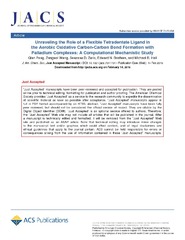Приказ основних података о документу
Unraveling the Role of a Flexible Tetradentate Ligand in the Aerobic Oxidative Carbon-Carbon Bond Formation with Palladium Complexes: A Computational Mechanistic Study
| dc.creator | Peng, Qian | |
| dc.creator | Wang, Zengwei | |
| dc.creator | Zarić, Snežana D. | |
| dc.creator | Brothers, Edward N. | |
| dc.creator | Hall, Michael B. | |
| dc.date.accessioned | 2019-08-22T09:36:42Z | |
| dc.date.available | 2019-02-14 | |
| dc.date.issued | 2018 | |
| dc.identifier.issn | 0002-7863 | |
| dc.identifier.uri | https://cherry.chem.bg.ac.rs/handle/123456789/3311 | |
| dc.description.abstract | Mechanistic details of the aerobic oxidative coupling of methyl groups by a novel (L-Me)Pd-II(Me)(2) complex with the tetradentate ligand, L-Me = N, N-dimethyl-2,11-diaza[3.3]-(2,6)pyridinophane, has been explored by density functional theory calculations. The calculated mechanism sheds light on the role of this ligand's flexibility in several stages of the reaction, especially as the oxidation state of the Pd changes. Ligand flexibility leads to diverse axial coordination modes, and it controls the availability of electrons by modulating the energies of high-lying molecular orbitals, particularly those with major d(z)(2) character. Solvent molecules, particularly water, appear essential in the aerobic oxidation of Pd-II by lowering the energy of the oxygen molecule's unoccupied molecular orbital and stabilizing the Pd-X-O-2 complex. Ligand flexibility and solvent coordination to oxygen are essential to the required spin-crossover for the transformation of high-valent Pd-X-O-2 complexes. A methyl cation pathway has been predicted by our calculations in transmetalation between Pd-II and Pd-IV intermediates to be preferred over methyl radical or methyl anion pathways. Combining an axial and equatorial methyl group is preferred in the reductive elimination pathway where roles are played by the ligand's flexibility and the fluxionality of trimethyl groups. | en |
| dc.publisher | Amer Chemical Soc, Washington | |
| dc.relation | info:eu-repo/grantAgreement/EC/FP7/912364/EU// | |
| dc.relation | CSA-trust grant | |
| dc.relation | Qatar National Research Fund under NPRP [7-297-1-051] | |
| dc.relation | 1000-Talent Youth Plan of Tianjin | |
| dc.relation | Welch Foundation [A-0648] | |
| dc.relation | 1000-Talent Youth Plan of China | |
| dc.relation | National Natural Science Foundation of China [21702109] | |
| dc.rights | embargoedAccess | |
| dc.source | Journal of the American Chemical Society | |
| dc.title | Unraveling the Role of a Flexible Tetradentate Ligand in the Aerobic Oxidative Carbon-Carbon Bond Formation with Palladium Complexes: A Computational Mechanistic Study | en |
| dc.type | article | |
| dc.rights.license | ARR | |
| dcterms.abstract | Wанг, Зенгwеи; Пенг, Qиан; Халл, Мицхаел Б.; Зарић, Снежана; Бротхерс, Едwард Н.; | |
| dc.citation.volume | 140 | |
| dc.citation.issue | 11 | |
| dc.citation.spage | 3929 | |
| dc.citation.epage | 3939 | |
| dc.identifier.wos | 000428356000022 | |
| dc.identifier.doi | 10.1021/jacs.7b11701 | |
| dc.citation.other | 140(11): 3929-3939 | |
| dc.citation.rank | aM21 | |
| dc.identifier.pmid | 29444572 | |
| dc.description.other | This is peer-reviewed version of the following article: Peng, Q.; Wang, Z.; Zarić, S. D.; Brothers, E. N.; Hall, M. B. Unraveling the Role of a Flexible Tetradentate Ligand in the Aerobic Oxidative Carbon-Carbon Bond Formation with Palladium Complexes: A Computational Mechanistic Study. Journal of the American Chemical Society 2018, 140 (11), 3929–3939. [https://doi.org/10.1021/jacs.7b11701] | |
| dc.description.other | Supplementary material: [http://cherry.chem.bg.ac.rs/handle/123456789/3310] | |
| dc.type.version | acceptedVersion | en |
| dc.identifier.scopus | 2-s2.0-85044361914 | |
| dc.identifier.fulltext | https://cherry.chem.bg.ac.rs/bitstream/id/14465/Unraveling_the_role_acc_2018.pdf |


